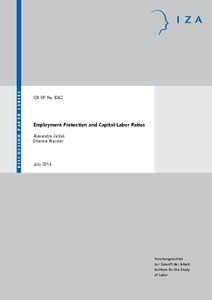Employment protection and capital-labor ratios
"Employment protection (EPL) has a well known negative impact on labor flows as well as an ambiguous but often negative effect on employment. In contrast, its impact on capital accumulation and capital-labor ratio is less well understood. The available empirical evidence suggests a non-monotoni...
| Main Authors: | , |
|---|---|
| Institution: | ETUI-European Trade Union Institute |
| Format: | TEXT |
| Language: | English |
| Published: |
Bonn
2014
IZA |
| Subjects: | |
| Online Access: | https://www.labourline.org/KENTIKA-19118194124919363769-employment-protection-and-capi.htm |
| _version_ | 1771659893853388801 |
|---|---|
| author | Janiak, Alexandre Wasmer, Etienne |
| author_facet | Janiak, Alexandre Wasmer, Etienne |
| collection | Library items |
| description | "Employment protection (EPL) has a well known negative impact on labor flows as well as an ambiguous but often negative effect on employment. In contrast, its impact on capital accumulation and capital-labor ratio is less well understood. The available empirical evidence suggests a non-monotonic relation between capital-labor ratios and EPL: positive at very low levels of EPL, and then negative. We explore the theoretical effects of EPL on physical capital in a model of a firm facing labor frictions. Under standard assumptions, theory always implies a motononic negative link between capital-labor ratios and EPL. For a positive link to arise, a very specific pattern of complementarity between capital and workers protected by EPL (senior workers, as opposed to unprotected new entrants, or junior workers) has to be assumed. Further, no standard production technology is able to reproduce the inverted U-shape pattern of the data. Instead, endogenous specific skills investment leads to an inverted U-shape pattern: EPL protects and therefore induces investments in specific skills. We develop such a model and calibrate the returns to seniority by using estimates from the empirical literature. Under complementarity between capital and specific human capital, physical capital and senior workers having accumulated specific human capital are de facto complement production factors and EPL may increase capital demand at the firm level. The paper concludes that labor market institutions may sometimes favor physical and human capital investments in second-best environments." |
| format | TEXT |
| id | 19118194124919363769_35cf089d42e84f6593420815dc1a9f12 |
| institution | ETUI-European Trade Union Institute |
| is_hierarchy_id | 19118194124919363769_35cf089d42e84f6593420815dc1a9f12 |
| is_hierarchy_title | Employment protection and capital-labor ratios |
| language | English |
| physical | 35 p. Digital |
| publishDate | 2014 |
| publisher | Bonn IZA |
| spellingShingle | Janiak, Alexandre Wasmer, Etienne employment security skill unemployment Employment protection and capital-labor ratios |
| thumbnail | https://www.labourline.org/Image_prev.jpg?Archive=109108092738 |
| title | Employment protection and capital-labor ratios |
| topic | employment security skill unemployment |
| url | https://www.labourline.org/KENTIKA-19118194124919363769-employment-protection-and-capi.htm |

